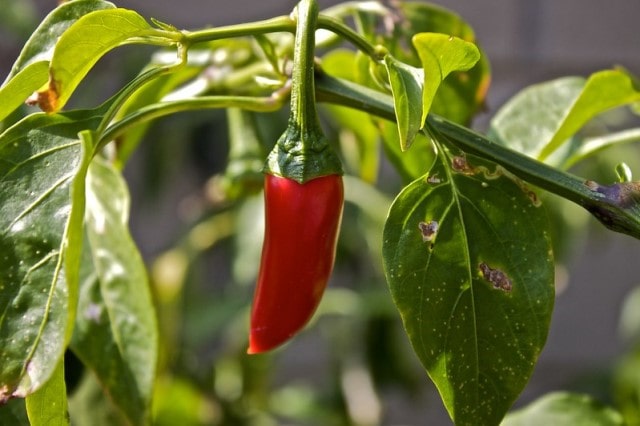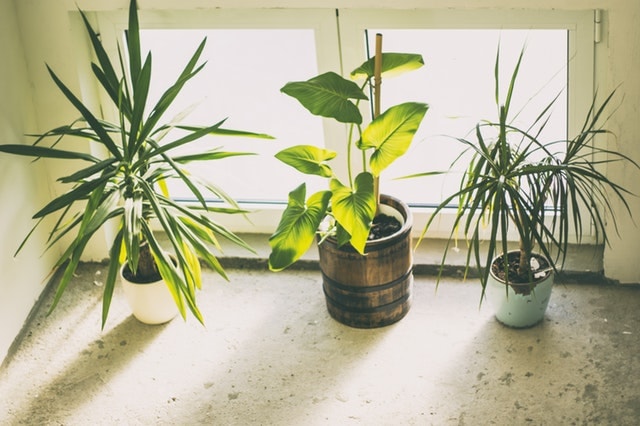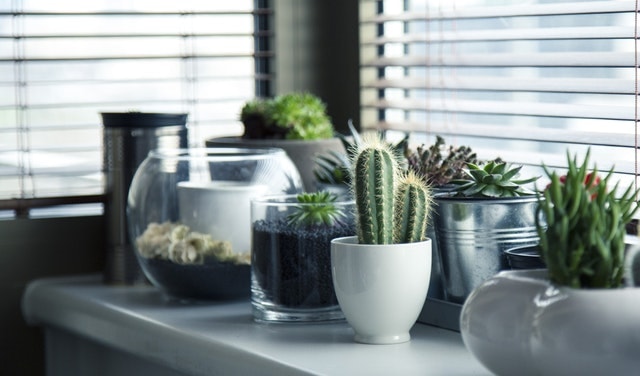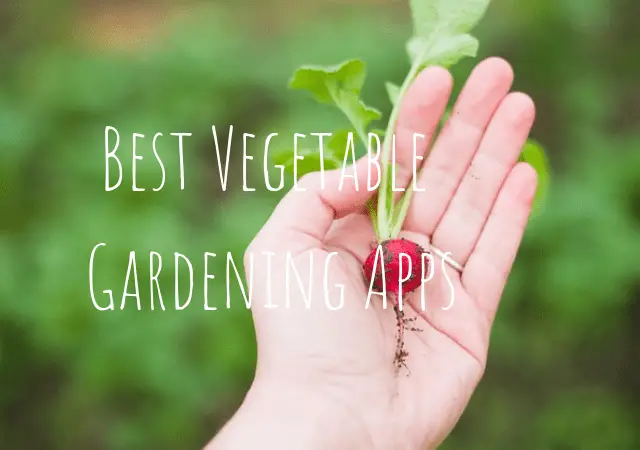Are you new to the garden? If yes, pepper plants are one of the easiest plants you can grow in the garden. You just have to grow the plants in a sunny place and water them frequently. The plant will remain vibrant, healthy and produce more peppers every year.
But the harvesting will not always remain the same. Certain pests can attack the pepper plant, or the plant can develop diseases that can reduce harvesting. You need to be familiar with such diseases so that it’s easy for you to identify and manage them.
The article discusses how to identify pepper plant diseases and manage them. So, keep reading this article to learn about some common diseases associated with pepper plants that decrease harvesting.
Pepper Plant Diseases
1. Bacteria Leaf Spot

It is one of the most common pepper plant diseases. When the pepper plant gets infected with leaf spot bacteria, it develops yellow spots on the leaves. These spots enlarge, become brown with time and then fall from the plant.
The plant is attacked by the leaf spot bacteria, mainly in rainy and humid climates. The bacteria spread quite easily through touch, soil, or seeds.
Identification Of Bacteria Leaf Spot
We list a few signs by which you can quickly identify that leaf spot bacteria infect the pepper plant.
- Yellow or green spots on foliage, and later, it will turn brown.
- Corky spots on pepper
- Pepper decay
- Leaves may fall from the plant.
Manage Bacterial Leaf Spot
- Remove The Infected Foliage
You need to identify the foliage with yellow or brown spots and then remove those leaves immediately. The bacteria leaf spot spreads quickly and will damage other plant leaves.
But if you observe that all the leaves have yellow or brown spots, then it’s better to remove the entire plant.
- Provide Proper Amount Of Fertilizer
You need to provide proper nutrition to the pepper plant from time to time so that it can better fight infection.
Let’s compare it with human beings. When a human eats good and nutritious food, his immune system strengthens. As a result, he can better fight any infection, microorganisms, and harmful bacteria. The same goes for the pepper plant.
Try to provide all-purpose fertilizer from time to time. But don’t provide too much fertilizer because excess salts can ultimately damage the plant.
- Spray Fungicide
You can spray Fungicide in the morning or evening to reduce the growth of leaf spot bacteria.
- Don’t wet The Foliage While Watering
If you observe any leaf spots on the pepper plant, you must carefully water the plant. We will recommend only providing water at the base of the pepper plant. If you spray water on the foliage, the spores of the bacteria can multiply very fast, infecting the plant more and more.
- Avoid Touching The Pepper Plant
Try to keep your garden clean. Use gloves in your garden while working with any plant, including pepper plants.
The bacteria leaf spot quickly spread through touch from one foliage to another. So, you must avoid touching the plant.
2. Mosaic Virus
The next disease your pepper plant can get affected by is a mosaic virus, which can attract insects. Once this virus invades the pepper plant, it’s pretty challenging to eliminate it. The virus can stunt the growth of the plant or reduce the harvesting.
The mosaic virus gets inside the plant through seed, soil, or any infected plant. But they are spread through the plant mainly by insects like aphids.
Identification Of Mosaic Virus
Below are a few signs you can easily identify that the mosaic virus infects the pepper plant.
- Low production of pepper
- The pepper plant stops growing
- Mottled leaves(leaves mottling starts from the base, move towards veins, and then to the base)
- Curl or wrinkle leaves
- The bumpy surface of the pepper
Manage Mosaic Virus
- Remove The Plant
There is no such particular treatment to remove the mosaic virus from a healthy pepper plant. So, if you suspect that the mosaic virus infects the pepper plant, then it’s better to remove the entire plant. The pepper is safe to eat. But don’t keep the seeds for planting the pepper. It is because the seeds can get infected by mosaic virus.
- Avoid Pests As Much As Possible
Mosaic virus is spread mainly by insects like aphids. So, you must avoid pests as much as possible in the pepper plant. It’s best to spray neem oil or any insecticidal soap on pepper plants from time o time to avoid insects.
- Keep Weeds In Control
Weeds can be a breeding place for insects. So, you must avoid weeds as much as possible.
You can remove the weeds manually or use a weeding hoe to keep weeds in control.
- Avoid To Touch Pepper Plant
You must avoid touching pepper plants as much as possible. Your hands can be a carrier of the mosaic virus, and it can spread from one foliage to another.
You need to wash your hands frequently while working in the garden. You have to do it during the rainy season mainly or when the pepper plant leaves are wet. Additionally, we will recommend sanitizing the gardening tools, mainly when you use them for pepper plants. You can sanitize them with bleach and water in a ratio of 1:4.
Avoid smoking in the garden because it can introduce mosaic viruses in the soil, which is, again, dangerous for the pepper plant.
- Always Look For Plants That Are Resistant To Viruses
Some pepper plant varieties are resistant to the tobacco mosaic virus. But unfortunately, no pepper plants are found to be resistant to the cucumber mosaic virus. So always look for the plants labeled TMV in any nursery for planting in your garden.
- Plant Aphid Repellant Plants
You can grow a few plants near the pepper plant, keeping aphids at bay. For instance, you can grow marigolds, garlic, and onion to keep aphids away.
3. Southern Blight
Southern Blight is a common disease in most plants, including pepper plants. In the summer, the disease mainly occurs by a soil-borne fungus, Sclerotium rolfsii.
Identification Of Southern Blight
- Discolored leaf
- Wilting of leaves
- Mycelia on the lower stem
Manage Southern Blight
Managing southern Blight is challenging because the fungicides required for removing the fungus are only available to commercial growers. However, cultural practices can be practiced to keep the disease in control.
- Sanitization
You can control the Southern blight disease by sanitization. The disease spreads through the infected soil, clinging to your shoes or garden tools. We recommend you remove the soil from the sole of your shoes, garden tool, or anything else before moving from one place in the garden to another.
Another best way is to grow pepper plants in a raised garden bed. It will remain isolated from the garden soil and prevent fungal disease from spreading.
- Remove The Infected Plant
If you find that the fungus southern blight infects the pepper plant, then it’s best to remove the entire plant. Simultaneously remove the mulch, soil, or any other debris which has come in contact with the pepper plant.
- Soil Solarization
It is a nonchemical method to kill soil-borne fungi. You have to cover the soil with a transparent plastic tarp and allow the top of the soil (2 inches)to reach at least 50 degrees Celsius. The high temperature will be sufficient to kill the fungus. The process is environmentally friendly as there is no involvement of chemicals.
If you tried everything but failed, calling a landscape professional is best. He will spray the fungicides required to eradicate southern blight disease.
4. Damping Off Disease
Damping off disease is a severe problem that can cause the death of pepper plants. It is caused by soil-borne fungi and molds that can kill or weaken the seeds before or after germination. Damping off disease is more prevalent in wet and cool conditions.
Identification Of Damping Off Disease
- The seeds will fail to sprout.
- Brown spots on the leaves
- Lower stems are changing their color to brown.
- Slimy foliage
Manage Damping Off Disease
- Keep Your Garden Clean
Your first duty is to maintain hygiene in your garden. You must clean all your garden tools with soap and water and allow them to dry thoroughly.
Clean your shoes with water because infected soil can cling to the soil and transmit from one garden area to another.
Additionally, clean your hands from time to time because your hands can be a good carrier for fungus and molds.
- Dont Overwater
Never overwater your plants because extra water can be a breeding ground for fungus and mold, ultimately damaging the pepper plant.
5. Powdery Mildew
Do your pepper leaves turn white from the underside? If yes, it is affected by powdery mildew, a fungus that is more prevalent in the summer and can significantly reduce pepper yield during harvesting.
It spreads mainly through wind, water splashing, human beings, and insects like aphids and white flies.
Powdery mildew will extract all the nutrients necessary for spurs’ growth. So it stunts the growth of pepper plants.
Identifications Of Powdery Mildew
- White or brownish powder structure appears on the underside or upper surface of the leaves.
- Leaf curling or twisting
- Yellowing of leaves
- Stunted growth
Manage Powdery Mildew
- Apply Fungicides
You must closely check the underside of the pepper plant leaves occasionally. If you find any white spots, spreading fungicides can help to hinder the spread of the disease.
Applying fungicides when you observe powdery mildew is an excellent solution to keep the disease in control.
- Never Overcrowd Plant
The spores of the powdery mildew can quickly spread from one plant to another by the wind. So you must keep a distance between two pepper plants.
Additionally, grow your peppers always in direct sunlight. Avoid weeds growing near the pepper plant because it can be a medium for the growth of pathogens.
- Provide Water Only At Base
You must provide water at the base of your pepper plant. Don’t splash water on the leaves because it can be the reason for the spread of the powdery mildew.
Additionally, provide water to the plant only in the morning so the leaves will be dehydrated by evening.
Never provide high-nitrogen fertilizer to your plant. It will make the pepper plant more prone to diseases.
- Apply Home Remedies
Specific home remedies can control the growth of powdery mildew. Researchers say that milk can prevent the spread of powdery mildew. Mix milk and water in a ratio of 1:9 and then put it in a spray bottle. Spray it all over the pepper plant to keep the disease in control.
Another excellent home remedy is baking soda and horticulture oil. You need to take a 4 L sprayer and fill it with water. Now add one tablespoon of baking soda and two tablespoons of horticulture oil. Mix everything thoroughly, and then start spraying in your pepper plant. It will help in preventing the spread of the disease.
The next home remedy is garlic cloves. You need to take two garlic cloves and blend them with some drops of liquid dish soap. Strain the mixture with a good kitchen strainer or cheesecloth to separate all the solid particles. You need to store the solid particles in the refrigerator.
Now mix the garlic extract and water in a ratio of 1:10 and spray on your pepper plant. The smell of garlic can be an excellent way to prevent the spread of diseases.
Plant Disease Identification Apps
Identifying a disease is quite difficult for a layperson. So people need easy ways to determine plant diseases rather than reading a book with hundreds of plant diseases.
Below are a few plant disease identification apps that can help diagnose plant disease.
1. Agrio
Agrio is a plant disease identification app. You need to upload the image to this application. The app will match it with the data in its database and provide accurate and correct information regarding plant disease.
2. Crops AI
Crops AI is an exciting app that helps in monitoring the health of a crop. The app currently supports only a few crops, but it will support more crops in the future. You need to upload the infected crop on the Crops AI app. It will give you the best regarding plant disease with the help of AI.
3. Plantix
Plantix is the next app which is fantastic to use. You have to upload the infected plant in the app, which will automatically give you information about the plant diseases.
The best thing is that the application is available in 18 regional languages. The user can ask any queries in the farmer community in your convenient language and will get answers within a few minutes.
The app will also guide you if you want to grow a new crop in your garden.
4. Leaf Doctor
Leaf Doctor is another application that can advise you regarding the leaves of an infected plant. You can access the severity of the leaf disease by using the leaf doctor application.
Conclusion
Pepper plants are pretty easy to grow in the garden. They even add a pleasant aroma to countless dishes. But pepper harvesting can get significantly reduced because of certain diseases. Some diseases can be irreversible, while others can be treated through fungicides or homemade spray.
We have discussed above certain diseases and how you can quickly identify and manage them, and we hope this article is helpful to you.



